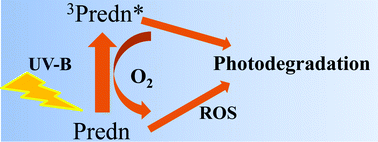当前位置:
X-MOL 学术
›
Photochem. Photobiol. Sci.
›
论文详情
Our official English website, www.x-mol.net, welcomes your
feedback! (Note: you will need to create a separate account there.)
Photodegradation of prednisolone under UVB solar irradiation. Role of photogenerated ROS in the degradation mechanism
Photochemical & Photobiological Sciences ( IF 2.7 ) Pub Date : 2017-10-10 00:00:00 , DOI: 10.1039/c7pp00200a R. Daniel Cacciari 1, 2, 3, 4, 5 , Eugenia Reynoso 1, 2, 3, 4, 5 , Hernán A. Montejano 1, 2, 3, 4, 5 , M. Alicia Biasutti 1, 2, 3, 4, 5
Photochemical & Photobiological Sciences ( IF 2.7 ) Pub Date : 2017-10-10 00:00:00 , DOI: 10.1039/c7pp00200a R. Daniel Cacciari 1, 2, 3, 4, 5 , Eugenia Reynoso 1, 2, 3, 4, 5 , Hernán A. Montejano 1, 2, 3, 4, 5 , M. Alicia Biasutti 1, 2, 3, 4, 5
Affiliation

|
The use of biologically active substances with anti-inflammatory properties such as corticosteroids has increased considerably in the last few decades. Particularly, the compound we are interested in, prednisolone (Predn), is a glucocorticoid with high biological activity. This compound absorbs UV radiation and may participate in photochemical processes, which can result in its own decomposition. These processes could result in the formation of free radicals or reactive oxygen species (ROS). On these grounds, the kinetic and mechanistic aspects of the direct photodegradation of Predn have been studied in aqueous medium under different atmospheric conditions by stationary and time-resolved techniques. The mechanism involved in the photodegradation has been elucidated. Predn is capable of generating the excited triplet state 3Predn* as a result of UVB light absorption. In the presence of oxygen, 3Predn* allows the formation of ROS, of which O2(1Δg) (ΦΔ = 0.014), H2O2 and the radical OH˙ stand out. The latter is generated from the spontaneous dismutation of O2˙− and subsequent homolytic cleavage, photochemically promoted, of H2O2. Predn undergoes unimolecular photodegradation reactions under an inert argon atmosphere. In this study we found that in the presence of oxygen, the Predn photo-consumption is improved. This implies that the attack by ROS involves a very important additional contribution to the photodegradation of Predn under aerobic conditions.
中文翻译:

UVB日光下强的松龙的光降解。光生活性氧在降解机理中的作用
在过去的几十年中,具有抗炎特性的生物活性物质(如皮质类固醇)的使用已大大增加。特别地,我们感兴趣的化合物泼尼松龙(Predn)是具有高生物活性的糖皮质激素。该化合物吸收紫外线辐射,并可能参与光化学过程,这可能导致其自身分解。这些过程可能导致自由基或活性氧(ROS)的形成。基于这些理由,已经通过固定和时间分辨技术研究了在不同大气条件下水性介质中Predn直接光降解的动力学和机理。已经阐明了光降解涉及的机理。Predn能够产生激发三重态3 Predn *由于吸收了UVB。在氧的存在下, 3 Predn *允许ROS的形成,其中的O- 2( 1 Δ克)( Φ Δ = 0.014),H 2 ö 2和自由基OH脱颖而出。后者是从的O-自发歧化生成2 ˙ -和随后的均裂,光化学促进的H, 2 ö 2。Predn在惰性氩气气氛下进行单分子光降解反应。在这项研究中,我们发现在氧气的存在下,Predn的光消耗得到了改善。这意味着在好氧条件下,ROS的攻击对Predn的光降解具有非常重要的额外贡献。
更新日期:2017-11-08
中文翻译:

UVB日光下强的松龙的光降解。光生活性氧在降解机理中的作用
在过去的几十年中,具有抗炎特性的生物活性物质(如皮质类固醇)的使用已大大增加。特别地,我们感兴趣的化合物泼尼松龙(Predn)是具有高生物活性的糖皮质激素。该化合物吸收紫外线辐射,并可能参与光化学过程,这可能导致其自身分解。这些过程可能导致自由基或活性氧(ROS)的形成。基于这些理由,已经通过固定和时间分辨技术研究了在不同大气条件下水性介质中Predn直接光降解的动力学和机理。已经阐明了光降解涉及的机理。Predn能够产生激发三重态3 Predn *由于吸收了UVB。在氧的存在下, 3 Predn *允许ROS的形成,其中的O- 2( 1 Δ克)( Φ Δ = 0.014),H 2 ö 2和自由基OH脱颖而出。后者是从的O-自发歧化生成2 ˙ -和随后的均裂,光化学促进的H, 2 ö 2。Predn在惰性氩气气氛下进行单分子光降解反应。在这项研究中,我们发现在氧气的存在下,Predn的光消耗得到了改善。这意味着在好氧条件下,ROS的攻击对Predn的光降解具有非常重要的额外贡献。











































 京公网安备 11010802027423号
京公网安备 11010802027423号